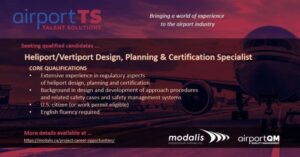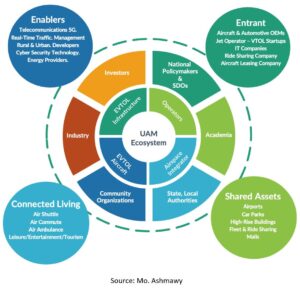The Future of the Urban Air Mobility Ecosystem
Mo. Ashmawy
January 20, 2021

 In 1958, the advertisement by American’s Independent Electric Light and Power Companies bragged that electricity would play a part in the higher standards of living and predicting that flying carpets (as the picture) will be part of people’s lives, thanks to the technology of the future, but today we are still desperately looking up to the sky with nothing but clouds in sight and the Jetsons-style flying cars that plug into an electric outlet for recharging still missing! If you’re still waiting with bated breath, don’t worry, the technology has long been science fiction, but thanks to recent technology updates, the Electric Vertical Takeoff and Landing (eVTOL) aircraft is a reality today and it is now attracting investors and entrepreneurs alike! Still, it doesn’t look like a flying carpet’s “yet,” but it is much more complicated than a flying carpet and the best punchline relating it was given by entrepreneur and investor Peter Thiel “We wanted flying cars; instead we got 140 characters.” Many say it is mobility in the third dimension. Still, for me, Urban Air Mobility and the eVTOL are the third revolutions in aviation, which started with getting us airborne, then getting us long-haul, and now is the era of “Flexing how we fly!”
In 1958, the advertisement by American’s Independent Electric Light and Power Companies bragged that electricity would play a part in the higher standards of living and predicting that flying carpets (as the picture) will be part of people’s lives, thanks to the technology of the future, but today we are still desperately looking up to the sky with nothing but clouds in sight and the Jetsons-style flying cars that plug into an electric outlet for recharging still missing! If you’re still waiting with bated breath, don’t worry, the technology has long been science fiction, but thanks to recent technology updates, the Electric Vertical Takeoff and Landing (eVTOL) aircraft is a reality today and it is now attracting investors and entrepreneurs alike! Still, it doesn’t look like a flying carpet’s “yet,” but it is much more complicated than a flying carpet and the best punchline relating it was given by entrepreneur and investor Peter Thiel “We wanted flying cars; instead we got 140 characters.” Many say it is mobility in the third dimension. Still, for me, Urban Air Mobility and the eVTOL are the third revolutions in aviation, which started with getting us airborne, then getting us long-haul, and now is the era of “Flexing how we fly!”
Flexing How We Fly!
The transportation and mobility market are enduring significant changes driven by the emergence of the Mobility-as-a-Service (MaaS) concept and the evolution of Mobility-on-Demand (MOD), in which generating user-centric mobility envisions a seamless door-to-door mobility service for end-users combining several modes of transportation and simply offer it in integrated platforms to the end-user. But all the efforts to overcome the limitation of the ground service to expand or optimization, the entire mobility system still stirring in two dimensions and the need to envisage the use of the third dimension, the Urban Air Mobility (UAM)/Advanced Air Mobility (AAM), became vital not a luxury or dream and UAM will be a reality before the next decade. UAM can alleviate pressure from the existing transportation system. Despite challenges, the Electrical Vertical Take-off and Land (eVTOL) manufacturers are advancing swiftly.  The Urban Air Mobility (UAM) and Unmanned Aerial Systems (UAS) market is at the introduction/development stage, with few competitors. Nonetheless, it is growing steadily, but the UAM/UAS is much vaster and more fragmented than the traditional manned aviation landscape and maintaining competitive advantage, firms should develop robust Urban Air Mobility Ecosystems driven from a well-designed business model and this is the “success factors” this article is attempt to explore. UAM Business Model The firms should start with precise market positioning and use a niche strategy to acquire early adopters and build a brand reputation. Value Creation
The Urban Air Mobility (UAM) and Unmanned Aerial Systems (UAS) market is at the introduction/development stage, with few competitors. Nonetheless, it is growing steadily, but the UAM/UAS is much vaster and more fragmented than the traditional manned aviation landscape and maintaining competitive advantage, firms should develop robust Urban Air Mobility Ecosystems driven from a well-designed business model and this is the “success factors” this article is attempt to explore. UAM Business Model The firms should start with precise market positioning and use a niche strategy to acquire early adopters and build a brand reputation. Value Creation  Three value propositions are generally proposed in connected, cooperative, and mobility category:
Three value propositions are generally proposed in connected, cooperative, and mobility category:
1) The offering of more environmentally friendly, economical, and efficient autonomous eVTOL’s,
2) The combination of advanced services and technologies which satisfy unmet needs, and
3) Integrated solutions with various technological functions and services.
Value Delivery Most of the innovations in the UAM sphere have not been formally commercialized in the market – they are still in the experimentation stage – therefore, the proposed value of these innovations is delivered mainly through their website. Presenting at international conferences and exhibitions is also a key channel to deliver value. Value Capture The current value capture mechanism is relatively conventional for these innovations – they capture value mainly through selling products or services – however selling an integrated solution, which combines technological functions to solve customer needs with value-added services, is the future direction for connection, cooperative, and mobility. UAM Ecosystems  The “success factors” of UAM will be heavily really on the development of the Ecosystem, and to strengthen collaboration within the UAM ecosystem, participants should develop and work on an integrated framework— spanning operators, Airspace integrator, eVTOL manufacturing, and infrastructure. This framework should afford a structure for promoting collaboration within the Ecosystem through alliances and partnerships, leveraging advancements in ground autonomy, and investing in cognitive (AI/ML) automation capabilities. The UAM Ecosystem requires expertise from multiple industry sectors as well government agencies, with a primary focus on the “CX” customer experience; it is vital in the build-out of the eVTOL business model is to consider the second set of ecosystem members as illustrated in the below UAM Ecosystem structure, where inner donut shows the prime function players, outer donut reflects the major stakeholders and external circles are the second set of the ecosystem members.
The “success factors” of UAM will be heavily really on the development of the Ecosystem, and to strengthen collaboration within the UAM ecosystem, participants should develop and work on an integrated framework— spanning operators, Airspace integrator, eVTOL manufacturing, and infrastructure. This framework should afford a structure for promoting collaboration within the Ecosystem through alliances and partnerships, leveraging advancements in ground autonomy, and investing in cognitive (AI/ML) automation capabilities. The UAM Ecosystem requires expertise from multiple industry sectors as well government agencies, with a primary focus on the “CX” customer experience; it is vital in the build-out of the eVTOL business model is to consider the second set of ecosystem members as illustrated in the below UAM Ecosystem structure, where inner donut shows the prime function players, outer donut reflects the major stakeholders and external circles are the second set of the ecosystem members.
Value Axis
To fully unlock the benefits of a partner ecosystem and gain competitive advantage, defining the value axis driven by the domain expertise, time to market, and value chain is crucial for the successful collaboration, and the ecosystems which do partner effectively will be able to serve their customers’ and markets’ needs. The eVTOL market success depends significantly on the willingness and ability of the UAM ecosystem partners to succeed as well – this requires firms’ culture that shifts its focus from an internal execution perspective to a comprehensive view of a partner ecosystem. The decision to develop a partner program is the decision to establish an ecosystem focus. Choosing the focus on the Ecosystem, rather than merely on the immediate environment of innovation, changes everything – from how to manage risk’s opportunities and threats, to how you think about time to market and positioning, to how you define and measure success. The new paradigm asks innovators to consider the entire Ecosystem by broadening their lens to develop a more unobstructed view of their full set of dependencies. Simply put, SYNERGY represents the core “Success Factor” for the UAM Ecosystem!
The eVTOL market success depends significantly on the willingness and ability of the UAM ecosystem partners to succeed as well – this requires firms’ culture that shifts its focus from an internal execution perspective to a comprehensive view of a partner ecosystem. The decision to develop a partner program is the decision to establish an ecosystem focus. Choosing the focus on the Ecosystem, rather than merely on the immediate environment of innovation, changes everything – from how to manage risk’s opportunities and threats, to how you think about time to market and positioning, to how you define and measure success. The new paradigm asks innovators to consider the entire Ecosystem by broadening their lens to develop a more unobstructed view of their full set of dependencies. Simply put, SYNERGY represents the core “Success Factor” for the UAM Ecosystem!
